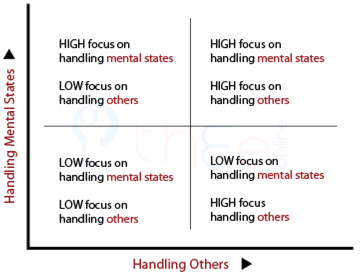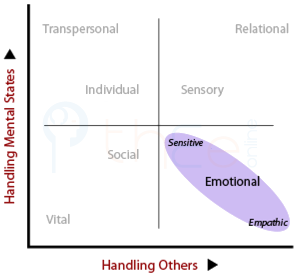Plotting the Methods
Reminder

Recall that the TET (Typology Essences Table) is a tool for displaying all in a way that differentiates them and illuminates their relationships. As explained, their field of operation must be a person's social life, the totality of everyday , which is continuously destabilizing in a myriad minor and unavoidable ways.
The next step is to consider each in turn and determine in broad terms:
- how much each requires a focus on handling mental states
- how much each requires a focus on handling others.
I will follow the same investigative style used elsewhere.
Start with Extreme Methods…
Y-Axis: Handling Mental States

The uses exercise and other physical activity (e.g. in work) for . Full concentration is required because incorrect postures or movements can cause temporary pain or even permanent structural damage. Feelings and ideas (as well as worries) may then be automatically pushed out of the mind or, if intrusive, just tolerated during activity. So this provides a very low focus on handling mental states.
X-Axis: Handling Others
The , being preoccupied with using one's body, does not necessitate interaction with any other person. Others may be sought as part of participation in team sports or competitive activities like tennis or athletics or as observers, but they are assumed to be willing, acting autonomously and looking after themselves. The itself therefore requires a very low focus on handling others.
We place at the lower left corner of the lower left quadrant.
Y-Axis: Handling Mental States

The demands full attention to mental states in order to sustain faith and realize union. Deliberate techniques, like contemplation or meditation, are used to notice and handle experiences of all sorts. Effort is required to recognize that most mental phenomena are unreal, inappropriate or distracting. The self must be mastered: it is viewed as an illusion or as the source of unnecessary distress. So we rate this very high on handling mental states.
X-Axis: Handling Others
Except for helpful guidance from a mentor or guru, others have little or no part to play in this . Some techniques may use group settings (e.g. in meditating or chanting) but there is minimal or stereotyped interaction with others. Teachings commonly emphasize kindness and compassion. However, if someone provokes or causes problems, simple adaptation, ignoring or physical withdrawal is preferred to getting involved. So there is a very low focus on handling others.
We place at the upper left corner of the upper left quadrant.
Y-Axis: Handling Mental States

The requires finding individuals with whom interaction is likely to be gratifying, and then developing an appropriately meaningful contact. Both the finding and the maintenance of relationships require close attention to the needs and preferences of the other party. The only way that these can be known is through attuning to feelings and intuiting the other's viewpoint. So we must place this very high on handling mental states.
X-Axis: Handling Others
The regards a continuous flow of gratifying interactions with a variety of other individuals as the basis for inner . No single partner can provide all that is required emotionally, and a number of other relationships of varying degrees of closeness are developed. As varying life trajectories mean that people may come and go, opportunities for new relationships are continually sought. It follows that this requires a very high focus on handling others.
We place at the upper right corner of the upper right quadrant.
Now for Centrally-located Methods…
Y-Axis: Handling Mental States

The requires actively participating in groups of various sorts and adopting their intrinsic values. This, together with finding purposes that suit you and the group, calls for focused awareness and a readiness to adjust. However, the situation is a stable one and the issues are relatively straightforward. So the focus on handling mental states seems to be in the lower half of the Y-Axis. Social awareness, diplomacy and compromise are necessary to handle member sensitivities and group politics. At the same time, priorities or tactics need to be adjusted. So the is more demanding than and is placed closer to the middle of the Y-Axis.
X-Axis: Handling Others
The requires a greater focus and dependence on the group rather than on specific members or people in general. So the focus on handling others seems to be in the lower half of the X-Axis. However, others are needed to enable group-related activities. Insufficient adjustment to their preferences and sensitivities could mean a loss of support for personal activities. At the extreme, this could block endeavours or lead to ejection from the group. So the method is placed closer to the middle of the X-Axis.
We place at the upper right corner of the lower left quadrant.
Y-Axis: Handling Mental States

The is preoccupied with self esteem and self-image issues, and receipt of respect. This calls for efforts to shape one's own thoughts and feelings. Knowledge of one's own natural tendencies and biases must also be developed for self-development and self-protection. Such a degree of continuing careful focus on inner mental states places the in the upper half of the Y-axis. However the intensity of control is less than is required for or , so it is placed closer to the middle of the Y-axis.
X-Axis: Handling Others
The entails associating with others in order to be valued and receive affirmation for a self-concept. Others are also viewed as essential for personal achievement and as suppliers of respect. These are distancing and instrumental attitudes, which places the method in the lower half of the X-axis. However, others must be handled sufficiently well to get what is desired, and certainly more than is required in the or , which locates it closer to the middle of the X-axis.
We place at the lower right corner of the upper left quadrant.
Y-Axis: Handling Mental States

The is about mixing with others with whom there is some shared interest or other commonality so as to get and to give positive attention. Finding and joining suitable circles or networks may not require much self-control, but inserting oneself over time in a way that is personally appropriate, socially welcomed and gratifying requires adeptness. Handling mental states is therefore on the high side i.e. in the upper half of the Y-axis, but not as high as or i.e. closer to the middle.
X-Axis: Handling Others
The involves relating positively with moderately large numbers of people. Ensuring that contact is appropriate requires discrimination and attention, while continuing membership of networks depends on interacting suitably. So the focus on handling others is on the high side too i.e. in the upper half of the X-axis. However, the depth and extent of personal involvement is lower than required for the , so it is closer to the middle of the X-axis.
We place at the lower left corner of the upper right quadrant.
Plot the remaining Method…

The focuses on immediate recognition and evaluation of feelings. These provide the psychological basis for what is real and important. Because the is primarily about simply containing (i.e. having or getting into) an emotional state, whatever it may be, it is low to very low on handling mental states. This places it in the lower half of the Y-axis.
Feelings present themselves as consequences of social situations or specific interactions involving others. These feelings often have to be worked out with the other or others involved—who may present an alternate view or even deny involvement altogether. So the tend to be high to very high on handling others and located on the right half of the X-axis.
Because people can vary in how they handle the twin requirements for , the forms a diffuse ellipse within the lower right quadrant: as shown in the diagram.
The extreme ends of this ellipse reveals the in two different and easily recognizable forms: at the upper left and at the lower right.![]() Details:►
Details:►
The next step is to use the above to make a variety of comparisons, starting with:
- labeling discrete zones of the axes;
- distinguishing central-peripheral concentric circles.
Originally posted: 15-Sep-2014. Last updated: 16-Dec-2014.
All posted material is part of a scientific project and should be regarded as provisional. Visitors are encouraged to think through the topics and propositions for themselves. Copyright © Warren Kinston 2009-2016.
All Rights Reserved.